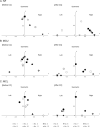Asymmetric epileptic spasms after corpus callosotomy in children with West syndrome may be a good indicator for unilateral epileptic focus and subsequent resective surgery
- PMID: 35869791
- PMCID: PMC9436295
- DOI: 10.1002/epi4.12631
Asymmetric epileptic spasms after corpus callosotomy in children with West syndrome may be a good indicator for unilateral epileptic focus and subsequent resective surgery
Abstract
Objective: This retrospective study was designed to observe differences in ictal movements of epileptic spasm (ES) before and after corpus callosotomy (CC). We hypothesized that asymmetric expression of ES is more clarified after CC and would be a good indicator for the epileptic hemisphere.
Methods: We selected 16 patients with intractable ES in West syndrome who were seizure-free after CC and subsequent resection or disconnective surgery of the unilateral hemisphere. We retrospectively reviewed their behavioral ES recorded at video-electroencephalography monitoring before and after CC. Asymmetric neck flexion (NF) and involuntary muscular contraction of the upper and lower extremities (MCU and MCL, respectively) were primarily described correlating their laterality and the responsible hemisphere proved by surgical resection.
Results: Asymmetric NF, MCU, and MCL could be found both before and after CC. However, the percentage of those movements to the total number of ES increased after CC; asymmetric NF, 82.9% vs. 20.1%; unilaterally predominant MCU, 81% vs. 39.3%; and unilaterally predominant MCL, 77.6% vs. 29.9%. Regarding asymmetric NF, the direction in which the neck flexed or the head turned was significantly ipsilateral to the responsible hemisphere in 9 of 12 patients after CC (75%). The predominant side of MCU and MCL were significantly contralateral to the responsible hemisphere in 11 of 11 and 7 of 9 patients (100% and 77.8%, respectively).
Significance: Asymmetric NF, MCU, and MCL were clarified in patients with ES who were successfully treated with CC and subsequent surgery. Those changes in ictal behaviors after CC may indicate the lateralization of epileptic activity and encourage more curative surgical treatment.
Keywords: corpus callosotomy; epilepsy surgery; epileptic spasms; west syndrome.
© 2022 The Authors. Epilepsia Open published by Wiley Periodicals LLC on behalf of International League Against Epilepsy.
Conflict of interest statement
None of the authors has any conflict of interest to disclose. Dr. Tomonori Ono is on the editorial board of Epilepsia Open.
Figures



Similar articles
-
Comparing late-onset epileptic spasm outcomes after corpus callosotomy and subsequent disconnection surgery between post-encephalitis/encephalopathy and non-encephalitis/encephalopathy.Epilepsia Open. 2023 Jun;8(2):346-359. doi: 10.1002/epi4.12698. Epub 2023 Feb 6. Epilepsia Open. 2023. PMID: 36692212 Free PMC article.
-
Surgical and developmental outcomes of corpus callosotomy for West syndrome in patients without MRI lesions.Epilepsia. 2018 Dec;59(12):2231-2239. doi: 10.1111/epi.14594. Epub 2018 Nov 5. Epilepsia. 2018. PMID: 30395353
-
Corpus callosotomy for drug-resistant spasms associated with tuberous sclerosis complex.Epilepsy Behav. 2019 Sep;98(Pt A):228-232. doi: 10.1016/j.yebeh.2019.06.007. Epub 2019 Aug 5. Epilepsy Behav. 2019. PMID: 31394351
-
Outcomes following resective and disconnective strategies in the treatment of epileptic spasms: a systematic review of the literature and individual patient data meta-analysis.Front Neurol. 2024 Dec 30;15:1518554. doi: 10.3389/fneur.2024.1518554. eCollection 2024. Front Neurol. 2024. PMID: 39807246 Free PMC article.
-
Corpus Callosotomy for Controlling Epileptic Spasms: A Proposal for Surgical Selection.Brain Sci. 2021 Dec 1;11(12):1601. doi: 10.3390/brainsci11121601. Brain Sci. 2021. PMID: 34942903 Free PMC article. Review.
Cited by
-
Comparing late-onset epileptic spasm outcomes after corpus callosotomy and subsequent disconnection surgery between post-encephalitis/encephalopathy and non-encephalitis/encephalopathy.Epilepsia Open. 2023 Jun;8(2):346-359. doi: 10.1002/epi4.12698. Epub 2023 Feb 6. Epilepsia Open. 2023. PMID: 36692212 Free PMC article.
-
Prediction model for long-term seizure and developmental outcomes among children with infantile epileptic spasms syndrome.Front Neurol. 2023 Jul 14;14:1195252. doi: 10.3389/fneur.2023.1195252. eCollection 2023. Front Neurol. 2023. PMID: 37521298 Free PMC article.
References
-
- Pellock JM, Hrachovy R, Shinnar S, Baram TZ, Bettis D, Dlugos DJ, et al. Infantile spasms: a U.S. consensus report. Epilepsia. 2010;51:2175–89. - PubMed
-
- Hrachovy RA, Frost JD Jr. Infantile epileptic encephalopathy with hypsarrhythmia (infantile spasms/West syndrome). J Clin Neurophysiol. 2003;20:408–25. - PubMed
-
- Kang JW, Rhie SK, Yu R, Eom S, Hong W, Kim SH, et al. Seizure outcome of infantile spasms with focal cortical dysplasia. Brain Dev. 2013;35:816–20. - PubMed
-
- Yum MS, Ko TS, Lee JK, Hong S, Kim DS, Kim J, et al. Surgical treatment for localization‐related infantile spasms: excellent long‐term outcomes. Clin Neurol Neurosurg. 2011;113:213–7. - PubMed

